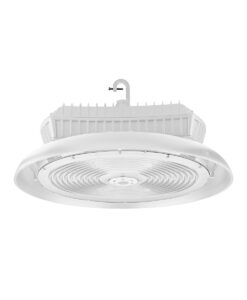In industrial operations, the pursuit of efficiency is a cornerstone for sustainable growth and cost-effective practices. Among the many avenues available, one often overlooked but significantly impactful aspect is warehouse lighting. The transition from conventional lighting to energy-efficient LED solutions isn’t just a mere change of bulbs; it’s a strategic investment with profound implications for the bottom line, sustainability, and operational excellence.
Cost Analysis: Shedding Light On Savings
The transition to LED warehouse lighting often begins with a meticulous examination of LED warehouse lighting costs. Initial apprehensions about higher upfront expenses can obscure the broader financial perspective. A comprehensive cost analysis, particularly regarding LED warehouse lighting cost, is imperative. While LED fixtures may demand a higher initial investment, their extended lifespan and significantly lower energy consumption become pivotal factors in reducing LED warehouse lighting costs. Consider this: traditional lighting sources, such as fluorescent or incandescent bulbs, require frequent replacements, resulting in ongoing maintenance costs and operational disruptions. On the other hand, LEDs boast an average lifespan of 50,000 hours or more, drastically reducing maintenance needs and associated expenses.
Moreover, their energy efficiency translates directly into substantial savings on utility bills, offering an attractive return on investment over the long run. When juxtaposed with the continuous expenditure on conventional lighting, the financial advantage of LEDs becomes evident. Additionally, incentives and rebates provided by many governments and utility companies further sweeten the deal, easing the financial burden of the initial LED warehouse lighting cost investment and hastening the path to cost recovery.
Operational Benefits: Brightening Efficiency
Operational efficiency stands as the linchpin of any warehouse’s success. The advent of LED warehouse lighting revolutionizes the operational landscape by enhancing visibility, safety, and productivity. LED lights radiate a superior brightness that illuminates every nook and cranny of the warehouse, significantly improving visibility compared to their traditional counterparts. This heightened visibility mitigates errors, reduces accidents, and expedites task completion, boosting overall operational efficiency. The instant-on feature of LEDs eradicates the need for warm-up time, ensuring immediate illumination when needed, thus eliminating operational delays and improving workflow consistency.
Furthermore, the minimal heat emission of LEDs contributes to a more comfortable working environment for warehouse staff and decreases the load on cooling systems, potentially reducing associated costs. Beyond these tangible benefits, the reliability of LED lights translates into reduced downtime, allowing for uninterrupted operations and minimizing disruptions in a warehouse’s bustling environment. These operational enhancements underline the transformative potential of LED lighting beyond mere energy efficiency.
Environmental Impact: Illuminating Sustainability
Beyond the immediate financial gains, the adoption of LED warehouse lighting resonates profoundly with broader environmental stewardship. LED technology’s inherent energy efficiency translates into a remarkable reduction in carbon emissions. By consuming significantly less energy compared to traditional lighting sources, LED lights contribute to curbing greenhouse gas emissions. This reduction aligns seamlessly with sustainability objectives, positioning businesses as conscientious contributors to a greener future. The cumulative impact of numerous warehouses switching to LED lighting can result in substantial environmental conservation. Moreover, the longevity of LED fixtures significantly reduces the waste generated from discarded bulbs, aligning with a circular economy ethos. This longevity minimizes the ecological footprint associated with the manufacturing, transportation, and disposal of lighting products, reflecting a commitment to responsible resource utilization.
Risk Assessment: Illumination And Reliability
The transition to LED warehouse lighting comes imbued with minimal inherent risk, primarily owing to the proven reliability and advancements in LED technology. The extended lifespan of LEDs, often surpassing 50,000 hours, and their durable design minimize the risk of frequent replacements and maintenance issues. Moreover, LED solutions’ market saturation ensures many reliable options, fostering competition that bolsters product quality and innovation. As with any investment, prudent risk assessment necessitates careful consideration of supplier reliability and product warranties. However, the track record of LED technology in delivering on promises of efficiency and longevity renders it a low-risk, high-reward investment for warehouse operations. Additionally, the gradual adoption of LED solutions allows for a phased approach, mitigating the risk of large-scale investments upfront. This strategic approach enables businesses to evaluate performance, fine-tune lighting designs, and scale implementation based on operational needs, minimizing potential risks associated with swift and comprehensive transitions.
Long-Term ROI And Scalability: Lighting the Path Forward
The real allure of LED warehouse lighting lies in its immediate benefits and its profound impact on long-term returns and scalability. While the initial investment might appear substantial, the savings from reduced energy consumption and maintenance costs rapidly overshadow this upfront expense. Over the lifespan of LED fixtures, businesses witness a substantial decrease in operational expenses, leading to a compelling return on investment. Moreover, the scalability of LED solutions empowers businesses to tailor lighting upgrades according to their budgetary constraints and operational requirements. This phased approach allows for a smoother integration of LED systems while maximizing benefits without overwhelming the initial investment. The scalability aspect further extends to the adaptability of LED lighting systems, enabling businesses to fine-tune and customize lighting solutions as their operational needs evolve, ensuring sustained efficiency gains.
Conclusion
Investing in energy-efficient LED warehouse lighting transcends the immediate cost considerations. It’s a strategic maneuver that slashes operational expenses, amplifies productivity, fortifies sustainability initiatives, and secures a solid return on investment over the long haul. Embracing this change illuminates a path toward a more efficient, eco-friendly, and economically viable future for industrial enterprises.



